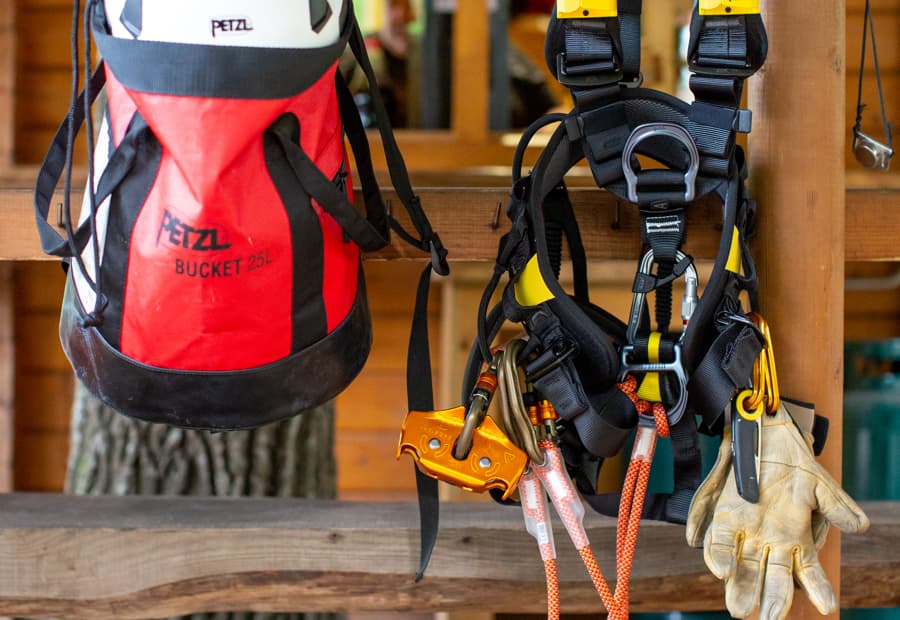
Good practice includes appropriate equipment selection, regular checks of gear, scheduled maintenance, up to date records and retirement processes.
Emergency equipment must be included in these processes, however for good practice advice specific to emergency equipment, including communication systems. Emergency equipment must be sufficient for the size of the group and suitable for dealing with the operation’s emergency scenarios as identified in risk management processes. It must also meet established good practice standards for the activity you are providing. Rescue from Height training with a prepared set of emergency rescue equipment is a vital part of any aerial activity such as climbing walls or aerial trekking.
Selection
It is important to check industry standards when deciding what equipment to use and to seek advice from trained professionals.
- Consider activity set-up and operation, all your identified emergency scenarios, and build in contingency for broken equipment.
- Remember that safety equipment often includes warm clothing in winter and sunscreen in summer.
- Sufficient quantity and, where relevant, a range of sizes is important. Remember gear specifications and guidelines when dealing with large clients.
- Equipment should be used according to manufacturer’s instructions – consider this carefully when making selections. See Petzl range of adventure centre equipment here.
- Make sure the right staff with right knowledge, expertinece, and training are involved in the selection process (consider using external experts).
Continual checks & Good Record Keeping
- Check equipment before and during use to ensure it is in safe working condition – don’t solely on scheduled maintenance or inspection programmes. A visual check pre activity should be carried out by all instructors and safety staff.
- Damaged/unsuitable equipment should not be used and must be removed from use and isolated e.g. clearly marked ‘not safe for use’ or put in an agreed ‘out of service’ area
- Record or report damaged or missing items in a way that prompts their timely replacement or repair. Involve staff in this process to ensure accountability.
- Use equipment logs to help encourage checks, i.e. sign equipment out as fit for purpose before use and sign in on return. Use a system such as Papertrail for digital PPE record keeping
- Remember to check the condition of equipment that you have hired before use.
Staff equipment
- Where the equipment’s primary function is safety, suitable PPE equipment must be provided for staff to use, e.g. helmets, harnesses, cows tails etc.
- Staff can choose to supply their own clothing and equipment for reasons of comfort and convenience, but an employer can’t require this of them.
- When staff choose to supply their own safety clothing and equipment, you must be sure that it is in suitable condition and meets industry good practice standards. Ensure that staff equipment checks are recorded.
Use, inspection and equipment maintenance
Correct use, inspection and maintenance of equipment will help ensure it’s not the cause of incidents. Therefore:
- ensure that SOP’s specify the safety equipment required for the activity. This should included operation of the activity as well as emergency equipment
- train staff in the use of standard and emergency equipment and record the training in a log book – supervise staff until they are able to use equipment safely
- ensure staff know they are individually responsible for ensuring that equipment is in good condition by doing thorough checks, raising concerns and requesting feedback and involvement of staff
- appoint someone with appropriate technical and professional expertise to take responsibility for equipment
- carry out maintenance in accordance with the manufacturer’s recommendations. All manufacturers have guidelines for equipment use. See Petzl PPE Checklist and PPE Inspection Procedure.
- schedule in-depth inspections and include regular equipment checks in SOP’s e.g. prompts for pre and post use checks in trip paperwork or pre/post activity
- in-depth inspections should include a check of equipment logs for any notes/concerns, and result in updated equipment records, including what is due for replacement. Request feedback from staff
- correct storage and good everyday equipment care are essential – a strong safety culture helps to ensure this will happen and induction of new staff is an opportunity to keep this alive
- ensure you will know if the equipment you use is recalled by a manufacturer – connections with outdoor sector organisations, social media pages of manufacturers, and other operators will help with this.
Record keeping
Recording the purchase, use and maintenance of equipment helps to ensure it’s life-cycle is suitably monitored. It also develops an increased understanding of its expected lifespan specific to your centre, climbing wall, or operation.
Develop a maintenance and inspection schedule and use tools such as equipment logs as a system to trigger equipment replacement.
When establishing a record keeping system ensure that you record details such as:
- equipment type
- serial number
- date purchased
- any identifying markings
- intended usage and usage restrictions
- retirement information
A variety of systems can be used to record and track equipment information including:
- labelling with company name and purchase date
- individual identifiers such as coloured tags. see Tough Tags
- a batching approach (record the number of items in the batch and inspect them all on the same cycle)
- keeping detailed equipment logs and retirement schedules where necessary, e.g. rope use – dynamic and static
- keeping registers/log books for each vehicle and include details of inspections, damage, repairs and maintenance
Retirement
Include the following in your equipment retirement process:
- follow the manufacturer’s recommendations on retirement requirements
- check with other operators, national organisations or the regulator if a manufacturer’s guidelines are not clear
- monitor levels and conditions of equipment use and storage, all of which may influence retirement dates.
